Premium
Branded Beef
ブランド牛
トップファームグループの牛は、
北海道生まれ。
黒毛和種と交雑種の2種類の
肉牛を育てています。
Top farm cattle is raised in Hokkaido.
We raise Saroma Wagyu and Hybrids.

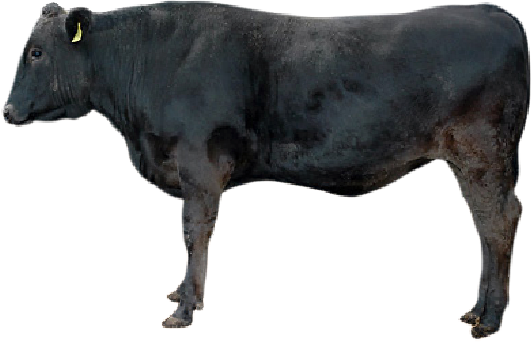
サロマ和牛(黒毛和種)
Saroma Wagyu (Japanese Black)
高級牛肉の代名詞「WAGYU」。
脂肪がキメ細かく交雑する
繊細な肉質です。
This meat is a luxury meat name.
The fat intertwines perfectly with the meat.
かつては農耕に利用されてきた黒毛和種。ほかの肉牛と比べると小型です。肉質はキメ細かく上質で、筋肉の間に脂肪が交雑し、いわゆる「サシ」「霜降り」と呼ばれる状態になるのが特徴。この「サシ」「霜降り」が入ることによって、肉はとても柔らかい肉質になり、豊かな風味が口の中に広がっていきます。こうした脂肪交雑の遺伝子を持つ肉牛は海外にはほとんどなく、「WAGYU」は高級牛肉の代名詞となっています。
サロマ黒牛は、生後2カ月から出荷までトップファームグループで一貫生産。一部は繁殖から自社で手掛けています。
Wagyu was once used for agriculture. They are regularly smaller than the average cow. The meat is very high quality.
One of its features is its marble look, created by the thin fat in between the meat. Because of this marble effect of fat, the meat goes easily into your mouth.This feature is considered rare even in other countries. Here at top farm, we take pride in taking care of our cows from 2 months from birth, until shipping.
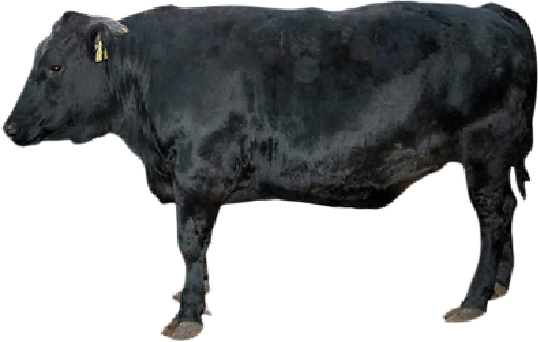
サロマ黒牛(交雑種)
Saroma Kuroushi (Hybrids)
和牛の味のよさ、乳用種の成長の早さ。
両者の利点を受け継いだ
コスパの高い牛肉です。
Wagyu`s incredible taste and the speed of dairy seeds.
Hybrids have combined these 2 points and is still
a reasonable price.
ホルスタインと黒毛和種を掛け合わせた交雑種は、ホルスタインの肉付きのよさ、和牛の味のよさを兼ね備えています。黒毛和種よりも赤身の多い肉質ですが、脂のしつこさもなく、価格も比較的リーズナブル。近年は消費者の高齢化や健康志向もあり人気が高まっています。
現在トップファームグループで出荷する肉牛の7割はサロマ黒牛。ステーキはもちろん、焼肉、すき焼き、牛丼、肉じゃがなど、幅広い料理で味わえます。
The combination of Holstein and Japanese has the fatty meat of a Holstein and all the delicious qualities of Japanese beef.
Hybrid meat is more red than the average Japanese beef, but is not too fatty and is a reasonable price.
Recently our buyers have been getting older and have more interest in healthcare. The meat shipped from top farm is 70% Saroma Wagyu.
There are many ways to eat this; such as steak, fried meat, sukiyaki, nikujyaga and gyudon.
餌へのこだわり
Commitment to Food
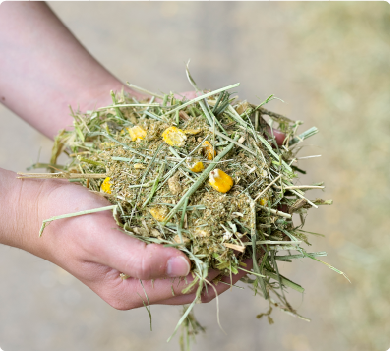
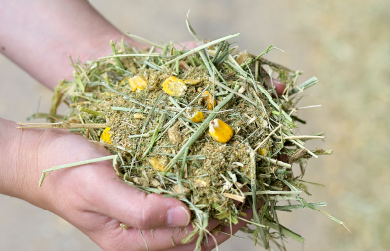
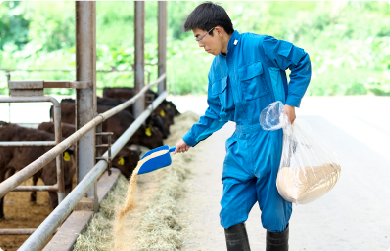
牛の胃を健やかに保つために、
独自の発酵飼料を与えています。
To keep our cows stomachs healthy,
we feed our cows original fermented food.
牧草や稲わらなど繊維質の多い粗飼料のほか、独自の発酵飼料をふんだんに与えています。
牧草とデントコーンは自社生産したものをサイレージ化。さらに、中国大連に設立した合弁会社から酵母発酵のオリジナル飼料を、ベトナムの契約会社からパイナップルやサトウキビを加工した乳酸発酵のエサを輸入しています。これらを組み合わせ、牛の成長に応じて調整しながら給餌することで、胃の中の微生物の働きを活性化。
おなかの調子を整えて、臭みのないお肉に仕上げています。
Aside from fiber foods, such as grass, we also feed the cows fermented food. We silage dent corn and grass made here at top farm. We also import dairy fermented food such as pineapple and corn from a copany that is connected to us in China. We adjust the combinations of these foods to go along with the groth of the cows to keep the bacteria in their stomachs healthy. Be keeping their stomachs healthy, there is less odor.
健康な牛づくり
Creating a Healthy Cow
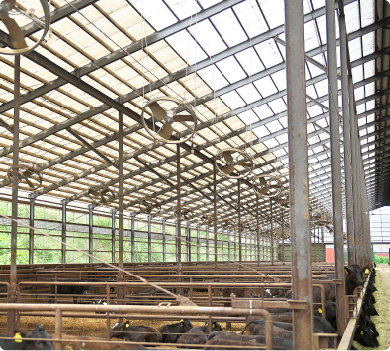
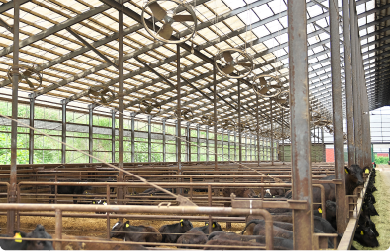
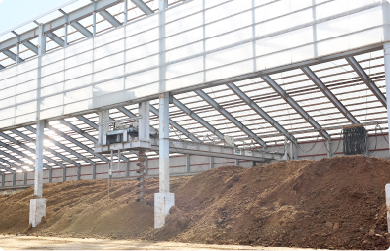
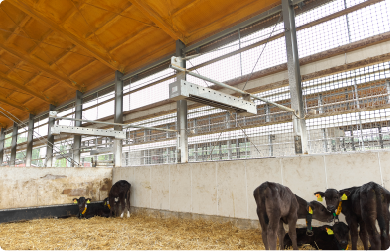
排せつ物はリサイクル堆肥化。
牛舎の敷料や土づくりに
再利用しています。
We recycle their excrement into fertilizer.
We then use the fertilizer for making soil
for the cows.
当社の牛舎を訪れた方は、鼻につく臭いがないことに気が付くでしょう。
嫌な臭いがしないのは、発酵飼料のおかげで排泄物のアンモニア臭がもともと少ないのに加え、除ふんや清掃をこまめに行って清潔を保っているからです。ふん尿は堆肥舎で寝かせて完熟発酵させ、水分を調整してリサイクル堆肥化。牧草の畑に還元し、牛舎の敷料に再活用しているほか、堆肥として近隣の畑作農家に提供しています。
目指しているのは自然環境に負荷をかけない循環型農業です。
If you visit our farm, you will probably realize that there is no pesky odor. This is because we feed our cows fermented food. By doing this, it eliminates ammonia. Another reason that there is no odor, is because we frequently remove the cows excrement and keep their stables very clean. The cows excrement ferments in a stable dedicated for just this. This place is called the soil stable. We then change the water level accordingly so it could be recycled into soil. Aside from reducing it on the fields and on the flooring of the stables, we also offer our soil to other farms nearby. We are trying to achieve an environment friendly farming style.
牛の管理体制
Managing the Cows
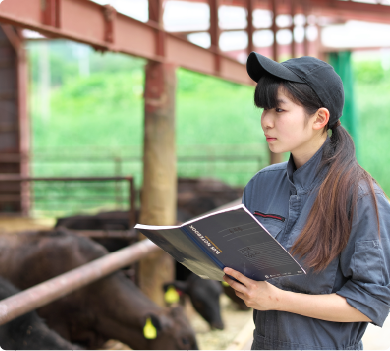
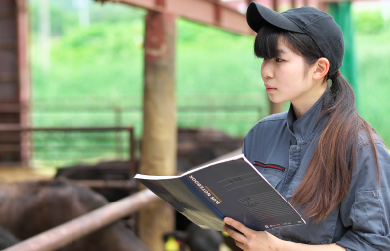

最新のICTやロボットを導入。
すべての牛のデータを
一元管理しています。
We use the latest ICT and robots.
Using this, we are able to manage all the
data of cows at once.
グループ内で飼養している牛の情報は、すべてパソコンの「牛生体管理システム」で一元管理しています。
黄色い耳標の個体識別番号とは別に、当社独自の管理番号を牛一頭一頭に割り振り、その番号で血統からワクチンの投与、計量の記録、与えたエサや治療歴までデータ管理します。
牛舎を移動し担当者が変わっても、生育の履歴を素早く確認でき健康管理に役立てられており、最大限のトレーサビリティを実現しています。
We manage all of the cows data using a program called “Cows health management system” on all of the computers. Aside from the typical yellow ear tags, we use an additional tag to keep better track of our cows. We use this tag to manage their blood type, vaccines, weight, the amount of food we give them and their medical records. This way, even if the cows move farm s, the new farmers will easily be able to keep track of them. The additional tags also come in handy when we ship them; The tag also comes in handy when keeping track of their health, and it has the biggest traceability.


